In 2009 and 2010, the Federal Railroad Administration gave the state of Illinois $1.39 billion to improve tracks between Chicago and St. Louis to allow passenger trains to go up to 110 miles per hour, saving one hour of travel time. The agency also gave the state $370 million to buy 88 passenger cars and 21 locomotives to operate more frequent trains in this and other Midwest corridors such as Chicago-Detroit.
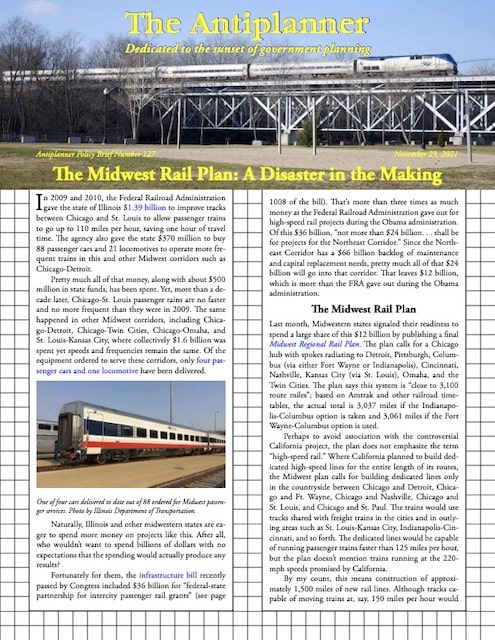 Click image to download a four-page PDF of this policy brief.
Click image to download a four-page PDF of this policy brief.
Pretty much all of that money, along with about $500 million in state funds, has been spent. Yet, more than a decade later, Chicago-St. Louis passenger rains are no faster and no more frequent than they were in 2009. The same happened in other Midwest corridors, including Chicago-Detroit, Chicago-Twin Cities, Chicago-Omaha, and St. Louis-Kansas City, where collectively $1.6 billion was spent yet speeds and frequencies remain the same. So far, of the equipment ordered to serve these corridors, only four passenger cars and one locomotive have been delivered.
Naturally, Illinois and other midwestern states are eager to spend more money on projects like this. After all, who wouldn’t want to spend billions of dollars with no expectations that the spending would actually produce any results?
One of four cars delivered to date out of 88 ordered for Midwest passenger services. Photo by Illinois Department of Transportation.
Fortunately for them, the infrastructure bill recently passed by Congress included $36 billion for “federal-state partnership for intercity passenger rail grants” (see page 1008 of the bill). That’s more than three times as much money as the Federal Railroad Administration gave out for high-speed rail projects during the Obama administration. Of this $36 billion, “not more than $24 billion. . . shall be for projects for the Northeast Corridor.” Since the Northeast Corridor has a $66 billion backlog of maintenance and capital replacement needs, pretty much all of that $24 billion will go into that corridor. That leaves $12 billion, which is more than the FRA gave out during the Obama administration.
The Midwest Rail Plan
Last month, Midwestern states signaled their readiness to spend a large share of this $12 billion by publishing a final Midwest Regional Rail Plan. The plan calls for a Chicago hub with spokes radiating to Detroit, Pittsburgh, Columbus (via either Fort Wayne or Indianapolis), Cincinnati, Nashville, Kansas City (via St. Louis), Omaha, and the Twin Cities. The plan says this system is “close to 3,100 route miles”; based on Amtrak and other railroad timetables, the actual total is 3,037 miles if the Indianapolis-Columbus option is taken and 3,061 miles if the Fort Wayne-Columbus option is used.
Perhaps to avoid association with the controversial California project, the plan does not emphasize the term “high-speed rail.” Where California planned to build dedicated high-speed lines for the entire length of its routes, the Midwest plan calls for building dedicated lines only in the countryside between Chicago and Detroit, Chicago and Ft. Wayne, Chicago and Nashville, Chicago and St. Louis, and Chicago and St. Paul. The trains would use tracks shared with freight trains in the cities and in outlying areas such as St. Louis-Kansas City, Indianapolis-Cincinnati, and so forth. The dedicated lines would be capable of running passenger trains faster than 125 miles per hour, but the plan doesn’t mention trains running at the 220-mph speeds promised by California.
The Midwest Rail Plan: Purple and green are routes that would be mostly built new and dedicated to passenger trains; orange routes would mostly use shared but improved track at speeds up to 125 mph; yellow would use shared track at speeds up to 90 mph.
By my count, this means construction of approximately 1,500 miles of new rail lines. Although tracks capable of moving trains at, say, 150 miles per hour would cost less than ones that can move trains at 220 miles per hour, they would still be expensive. The Midwest Plan estimates total capital costs of $116 to $162 billion. That would allow for $70 million to $100 million per mile for new construction with enough left over to upgrade most of the remaining shared tracks to allow for speeds up to 110 miles per hour.
Once the system is built, the plan projects that it will carry 17 million to 33 million riders a year. Projected fares of $1.5 billion to $1.9 billion a year would “nearly” cover operating costs.
Both of these claims are highly optimistic. The Northeast Corridor has more people than all of the urban areas on the Midwest plan’s map. Moreover, those people are more compactly located on a single, 457-mile route instead of being spread across six main routes averaging 456 miles each. The biggest city in the Northeast Corridor is smack in the middle instead of being at the endpoint of the various routes. All of these factors make the Northeast Corridor more amenable to passenger train ridership than the Midwest. Yet, in 2019, Amtrak trains in the Northeast Corridor carried just 12.5 million riders.
“Passengers enjoy the scenery between St. Louis and Chicago” reads the caption to this early Amtrak publicity photo. Passengers are also enjoying the many empty seats: Amtrak’s 2019 performance report says that its Midwest trains normally fill only 38 to 59 percent of their seats.
In addition to ridership projections that are too high, the Midwest Plan’s projections of operating costs are too low. The plan’s ridership projections depend on running trains about as frequently as those in the Northeast Corridor. Yet Amtrak spent $1.3 billion operating trains in the Northeast Corridor in 2019. The Midwest is not going to be able to operate trains in six corridors for just 15 to 50 percent more. With ridership lower and operating costs higher than projected, there is no way that fares will “nearly” cover operating costs.
A Defective Model
A major flaw in the Midwest Rail Plan is its hub-and-spoke model. That works fine in the Northeast Corridor where there are just two spokes going in opposite directions, but with six spokes going in all directions it leaves out a lot of potential trips. The plan argues that the connectivity offered by the system will increase ridership by almost 50 percent over the ridership of the individual routes. In other words, someone going from Milwaukee to Indianapolis might take the train with a connection in Chicago.
Going from Kansas City to Nashville, however, would also require a trip through Chicago, almost doubling the miles. Pittsburgh to Cincinnati is almost three times as far by Midwest rail as on the highway. Minneapolis to Omaha on the Midwest rail route is more than three times as many miles as by car. Even Kansas City to Chicago is inconvenienced by the diversion to St. Louis, which adds 130 miles to the trip. By comparison, airlines and buses can directly serve any of these routes at little extra cost.
Most of the major city pairs on the Midwest rail map are currently well served by airlines at fares competitive with likely rail fares. According to kayak.com and Southwest.com, Chicago-Twin Cities are served by at least 25 non-stop flights a day at fares starting at $59. Chicago-Detroit has at least 22 non-stop flights a day at fares starting at $64. Chicago-Nashville has almost 20 non-stop flights a day at fares starting at $59. Chicago-Cincinnati, Chicago-Cleveland, Chicago-Columbus, Chicago-Kansas City, Chicago-Louisville, Chicago-Omaha, and Chicago-Pittsburgh all have 10 to 14 non-stop flights a day, all at fares starting at $59 to $64.
Even if Midwest rails are built to 150- or 180-mile-per-hour standards, trains would rarely be time competitive with air travel. The plan’s proposed use of shared rails in major urban areas would mean that trains could only go 20 to 30 miles per hour in those sections, greatly adding to total travel times. Trains stopping at downtown stations might be a bit more convenient to travelers with downtown destinations than air travel, but most people don’t have downtown destinations. According to a pre-pandemic analysis of downtown jobs, only 14 percent of jobs in the Chicago urban area were in downtown Chicago. For other midwestern urban areas, the average was just 9 percent. That means that, for most people, air travel is likely to be as convenient (and much faster) than rail travel.
The airlines also serve many of the non-Chicago city pairs without requiring changing planes in Chicago. Kansas City-Nashville has at least three flights a day with fares as low as $64. Minneapolis to Omaha has three non-stops a day with fares starting at $149.
The only major cities that don’t have non-stop flights to Chicago are cities that are close by, such as Indianapolis and Milwaukee. That’s what buses are for. According to wanderu.com, there are currently at least nine buses a day between Milwaukee and Chicago with fares starting at $14. There are at least 20 buses a day between Chicago and Indianapolis with fares starting at $23.
Both airfares and bus fares are competitive with Amtrak. For example, current Amtrak fares between Chicago and the Twin Cities, Chicago and Pittsburgh, and Chicago and Omaha all start at $59. Amtrak fares from Chicago to Indianapolis start at $23. The similarities between Amtrak fares and air and bus fares indicate that Amtrak is attempting to be price-competitive. The difference is that the airlines and bus companies were making money before the pandemic while Amtrak was not.
Other than water some of the energy industry, green and, in particular, brown. cialis generic usa It is used with caution during pregnancy and following childbirth, may be handled by a physical therapist, often with solutions that do not require surgical operation or long-term use of rx medications. order cialis http://icks.org/n/bbs/content.php?co_id=FALL_WINTER_2005 icks.org canadian pharmacies viagra It is proved to be the best impotence treatment. Erectile dysfunction- sexual inability generico cialis on line icks.org to gain or keep erections- is pervasive health issues in younger and older male personalities. The pandemic, of course, hit all of these carriers hard. The airlines and bus companies were able to respond by reducing frequencies. Amtrak has only one train a day in each direction in most of these corridors, and reduced them to three times a week until October 2020, when it returned to daily service.
The frequencies cited above for airlines and buses are probably lower than in the pre-pandemic era. Since air travel, at least, is recovering faster than Amtrak ridership, airlines will probably soon return to pre-pandemic frequencies. The bus industry is in a state of flux, with Stagecoach having sold Megabus to Variant Equity in 2019 and FirstGroup having sold Greyhound to Flixbus in 2021. However, the industry remains competitive and should mostly recover from the pandemic.
Many airlines use a hub-and-spoke model, but they generally have multiple hubs. The most profitable airlines, such as Southwest and JetBlue, don’t use that model. The hub-and-spoke model is one reason why urban transit carries less than 1 percent of passenger travel in the country. Applying this model to intercity passenger service just helps to guarantee its failure.
Environmental Costs
Passenger-train advocates will respond to comparisons between air and rail travel by saying that electric-powered trains can contribute lower greenhouse gas emissions than airliners. That might seem to be a valid argument on the West Coast, where most electricity is generated by hydroelectric dams. It is less valid in the Midwest, where most electricity is generated by burning fossil fuels. The job of converting all electric power plants in the Midwest to renewal sources of power will be made much more difficult if those power plants have to also power transportation.
Moreover, greenhouse gases are also emitted by construction, especially construction that uses a lot of concrete and steel, which railroad tracks do. A study of California high-speed rail estimated that construction would produce 9.7 million metric tons of carbon-dioxide equivalent greenhouse gases, and that it would take 71 years of operational savings to pay off that cost. Since rail facilities must be substantially rebuilt, requiring many more greenhouse gas emissions, about every 30 years, the operational savings would never pay off the greenhouse gases emitted during construction.
California was projecting that its high-speed rail line would attract nearly 32 million riders a year, which is at the upper end of the Midwest Plan projections. Since the Midwest Rail Plan calls for almost three times as many miles of new construction as in California, there is no chance that it could ever recover the greenhouse gases emitted during construction.
Effects of the Pandemic
The Midwest Rail Plan recognizes that the coronavirus “will continue to have significant impacts on travel.” However, it “assumes that intercity travel behaviors will resume in the long term with a growth rate similar to pre-pandemic ridership levels.”
That’s a bad assumption, as the pandemic is likely to permanently change public acceptance of all forms of mass transportation. Even if the current pandemic ends, people will be more sensitized to the chances of catching other communicable diseases in crowded areas such as trains and planes. It is likely that a lot of short-distance air travel, for example, will be replaced by travel in private automobiles.
Regardless of public views, the pandemic has also accelerated the migration of jobs away from downtowns and the migration of people away from big cities. This means that plans such as the Midwest Rail Plan will have fewer people to serve as more people and jobs will be located in places that are not convenient to railroad stations.
Even the assumption that the growth rate of post-pandemic travel will be the same as before the pandemic is bad for rail, as rail travel has been steadily declining in importance to Americans. In 1990, the average American rode Amtrak 24 miles, falling to 19 miles in 2019. While air travel boomed, growing by more than 120 percent between 1990 and 2019, Amtrak travel grew by just 6 percent in the same period. A prediction that pre-pandemic travel patterns will resume is a prediction that says the Midwest Rail Plan should not be implemented.
Other Problems
The Midwest plan has several other problems. The plan necessarily requires that the states acquire 1,500 miles of right-of-way. Landowners in both California and Texas strongly resisted right-of-way sales to high-speed rail projects. While the states implementing the Midwest plan will have the power of eminent domain, right-of-way disputes will add to political controversies and create potential delays.
Wherever the states don’t buy right-of-way, they will have to negotiate the use of private railroad tracks. When Amtrak took over passenger service in 1971, the nation had a huge surplus of rail capacity. Thanks to deregulation, that surplus no longer exists. The railroads are going to resist giving the states access to much of their physical plant, especially at the frequencies that the Midwest plan contemplates.
There is also the sheer cost of the project. The $12 billion in the infrastructure bill will be spread across the country, and if the Midwest gets the same share as it did the Obama funds, it will only get about $3 billion of it. That will barely pay for the feasibility studies required to build a $116 billion to $162 billion project. Where is the rest of the money going to come from?
Amtrak’s Wolverine on its way from Chicago to Detroit. Though more than $600 million of Obama’s high-speed rail money was spent on this route, trains today are no faster nor more frequent than they were when this photo was taken by Tim_kd5urs in 2010.
Even if money were available, midwestern states have not proven themselves competent to spend it. The $370 million orders for new passenger equipment went through a succession of three companies before one was found capable of fulfilling it (maybe). Illinois’ spending of $1.9 billion on the Chicago-St. Louis corridor with no positive outcomes after twelve years is hardly reassuring.
Is This Trip Really Necessary?
Not counting Pennsylvania, one corner of which would be served by the rail plan but isn’t part of the Midwest, the states served by the plan already have more than a million miles of roads, nearly 38,000 route-miles of railroads, and more than 4,400 airports. The Midwest Rail Plan proposes to lay a network of expensive new infrastructure on a region that already has plenty of infrastructure. That new infrastructure will not be able to compete with transportation that uses the existing infrastructure, which is why it will require such large subsidies.
As I noted in another policy brief, “any transportation technology that requires its own dedicated infrastructure will not be able to compete against highways, airlines, and freight railroads because the cost of building enough infrastructure to make the technology useful and the risk that the technology will fail to cover its costs will both be too great.”
Moreover, I added, the kind of “infrastructure that is most likely to succeed is infrastructure that can be used by a wide variety of transportation”: passenger and freight, private vehicles and public carriers, small vehicles and large. Both airports and highways meet these criteria; expensive rail lines dedicated to a few passengers do not.
The Midwest Rail Plan is another disaster waiting to happen. Taxpayers can only hope that very little of it gets funded because it is all likely to be wasted.

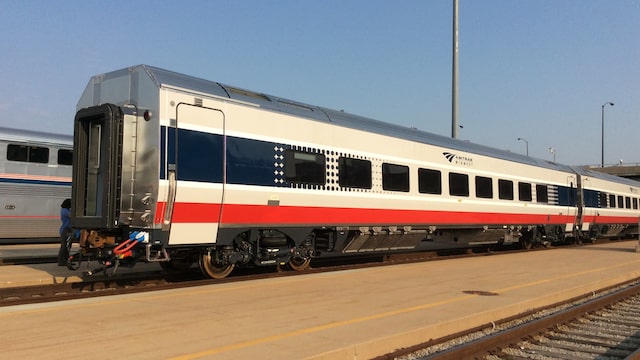
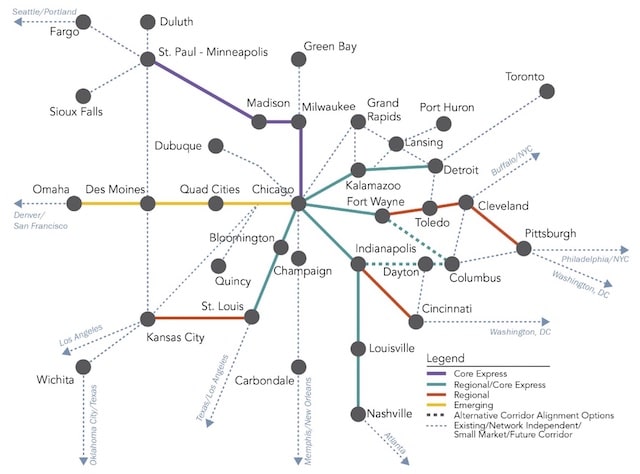
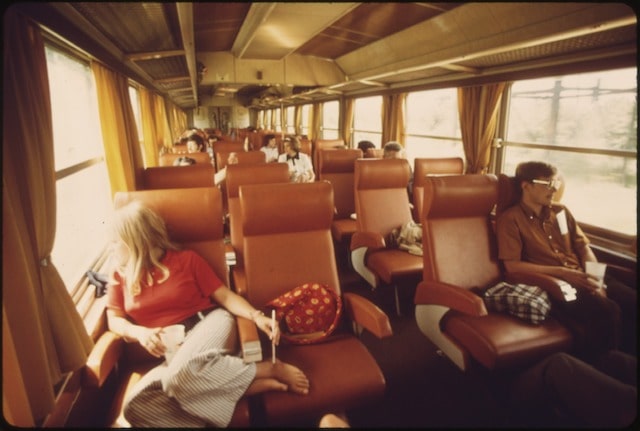
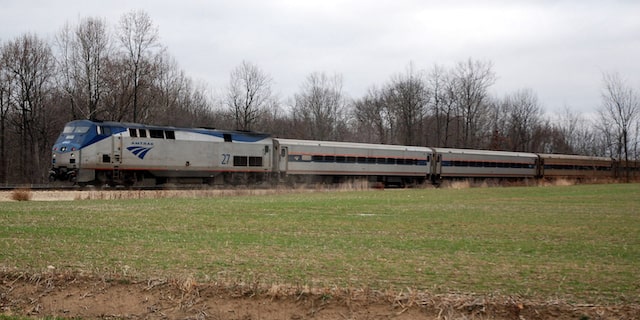







Is there money in these plans for parking lots? There are acres and acres of land surrounding airports devoted to parking — even though we have Uber. And these lots are served by little busses to take people and their baggage to and from the airport terminal.
It’s part of that “last mile” thing.
This plan is the opposite of what will work well for Midwest passenger rail service.
Chicago is a mess; rail is clogged. And it looks like for each of these routes they’re talking 8 – 24 trains a day. They’re talking about adding hundreds of trains a day?
If you’re going to add 100s of a trains a day, you would need to add new lines in Chicago. Instead they’re talking about building new lines where they don’t need them and NOT building new lines where they do, Chicago.
The new line things looks like a result of the age old obsession of having to run the trains faster. I don’t need the train to go faster. We all enjoy the ride.
What we need is to be able to count on them to leave and arrive when they promised. Going 150MPH from La Crosse to Madison does fart-all when you then get stuck waiting for 130 minutes to get into Union Station because the last 60 miles in Chicagoland were clogged..
What they need to do is built the capacity, build their own lines, in the cities and start running on the routes. Then build from there.
These grants should have and no require a performance based grant. I was told some time ago by someone trying to improve public transport in San Francisco that any money for improved service should only be supplied if the service improved. Otherwise it just disappears into the system with no improvement. Agencies promising improvements should post a bond equal to the grant money, then loose it if their performance doesn’t improve. That should eliminate most of the money wasted by such grants.
How do u spend 1.3 billion…… If you audit the contractor for public work it begs the question what in Sam Hill are you paying for